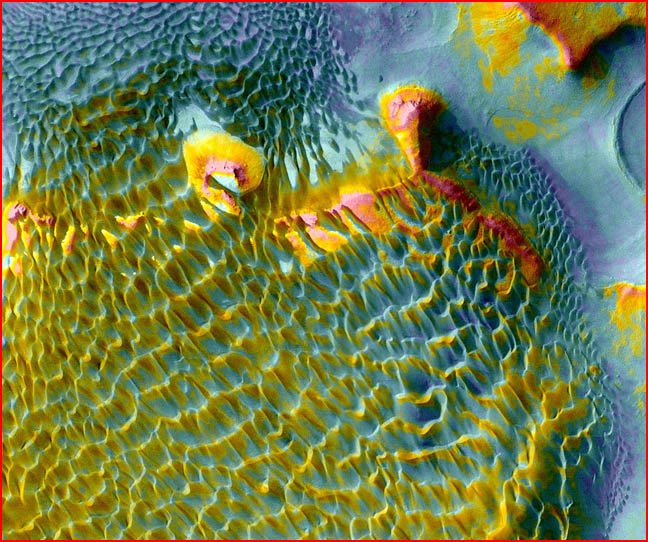
home •
about •
essential guide •
picture of the day •
thunderblogs •
news •
multimedia •
predictions •
products •
get involved •
contact
picture of the day archive subject index
False color image of the floor of Rabe Crater on Mars, taken by the Mars Odyssey Mission’s THEMIS
(Thermal Emission Imaging System).
Nov 29, 2006
The “Dunes” of Rabe Crater
Nothing is more ubiquitous on the surface of the planet Mars than vast ridge and valley networks that planetary scientists typically identify as “dunes.” But electrical theorists predict that the more scientists learn about these formations, the less plausible the traditional explanations will become.
To appreciate the significance of the image above, the reader will find it helpful to view the larger region at a higher resolution (image available here). The extraordinary image, in false color, gives important information on the relative “hardness” of different surface areas. “Hardness” is deduced from overnight surface temperatures, the warmer temperatures indicated in red, and the cooler ones indicated in blue. In explaining this technique, the authors of the THEMIS site note, “The technique works because areas mantled in dust cool off quickly after sundown, while rocks hold onto daytime heat much better.”
Applying this criteria to the image above, one would logically conclude that the crests of the so-called “dunes” are significantly harder than the valleys between them: over much of the “dune” region, the warmer colors follow the ridges quite consistently. Ridges of many sorts on Mars are of particular interest to the electrical theorists, who suggest that most formative processes on Mars bear little or no resemblance to textbook geology, while presenting numerous patterns suggestive of electrical forces. In this sense, Martian “dunes” may well provide an acid test of the electric model.
Perhaps the term that most readily separates an electrical view from conventional Martian geology is “glassification” (conversion of soil into fulgurite-like glassy material, and “electrical soil metamorphism” (the instant conversion of sand into sandstone). Conventional schools have never applied the term to formative processes on Mars. From an electrical perspective, surface metamorphism will be expected in numerous contexts. That is because the electric model suggests that every region of the planet has been electrically etched and/or excavated up to miles deep. Similarly, layers of material have been deposited (up to a few miles in depth, as exhibited along the cliff walls of Valles Marineris) following electrical excavation elsewhere on the planet.
Though the “dunes” occur on Mars in many different contexts, the most important consideration in the electrical interpretation is the role of coronal streamers in electrical discharge scarring. When an arc discharge cuts a pathway across a surface, for example, it can leave secondary “coronal” channels perpendicular to the primary channel itself—a principle of sweeping importance to an understanding of Martian geology. We have also noted the orthogonal cellular “dune structure” in the center of Victoria crater, remarkably similar to that of the Rabe crater seen above. Morphological similarities suggest a likely similarity in cause.
In particular, we would draw attention to the fractal-like reduction in scale with distance from the dominating elevations closer to the center of the “dune” field. The crests’ heights range up to 650 feet above their associated troughs. But with distance, the crests are diminished in scale to such a degree that, though retaining the same morphology, they disappear beneath the layers of fine material (in blue). So one question posed for geologists would apply not just to Rabe crater and not just to Victoria crater: What Aeolian process can account for this progressive and systematic fractal reduction in scale? In electrical terms, there is no anomaly in this, since electrical discharge phenomena can maintain the same morphology across many orders of magnitude.
From any conventional perspective, the entire context of the crater is anomalous. The origin of the crater and its unique flat floor is “unknown” according to the THEMIS team. The crater floor is distinguished by the presence of a pit that is a full kilometer deeper than the surrounding floor layer, though it is obviously layered substantially by falling debris. Its cause is also unknown.
Searching through the available NASA files on Rabe Crater, we can find no coherent explanation for its defining features. And yet the mysteries posed have many implications for the planet as a whole, and the patterns deserve careful examination from alternative vantage points. Indeed, the entire issue of Martian “sand dunes” should be open for reconsideration, and we will take up some of the more compelling reasons in coming Pictures of the Day.
___________________________________________________________________________Please visit our Forum
The Electric Sky and The Electric Universe available now!

|
|

|
EXECUTIVE EDITORS:
David Talbott, Wallace Thornhill
MANAGING EDITORS:
Steve Smith, Mel Acheson
CONTRIBUTING EDITORS: Dwardu Cardona, Ev Cochrane,
C.J. Ransom, Don Scott, Rens van der Sluijs, Ian Tresman
WEBMASTER: Brian Talbott
Copyright 2006: thunderbolts.info
![]()
home •
thunderblogs •
forum •
picture of the day •
resources •
team •
updates •
contact us

